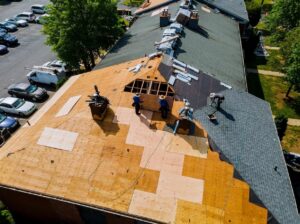What Types of Storm Damage Impact Residential Roofs?
Heavy winds and torrential downpours can significantly impact your property. It should be no surprise that your roof is susceptible to this type of damage. Since your roof plays an integral role in safeguarding your assets, it’s vital to protect the integrity of the roof.
Here are the most common types of storm damage that can impact residential roofs:
- Missing or broken shingles
- Wind damage
- Granule loss or flaking
- Water damage
- Buckling or blistering
- Hail damage
- Gutter damage
- Impact damage from fallen branches or debris
Since most roof damage is progressive, it’s essential to act fast with repairs. Additionally, roof damage can move into the interior of your home, especially with water issues. So, how do you know it’s time to call a local roofer for help? If you’d like to read more about What Does Wind Damage Look Like? Check see our post, How Does Wind Damage Affect Residential Roofing.
When Is It Time to Call a Local Roofer?
Aside from scheduling an annual routine roof inspection, it’s essential to watch for signs of roof damage before, during, and after bad weather. Check the condition of your roof when it’s safe to do so. Look for these five signs you need repairs:

1. Broken or Missing Shingles
Wind, rain, and hail can cause significant damage to your roof. Check your roof for cracked, split, dented, or missing shingles. You should also look for punctures on your roof’s surface.

2. Water Damage
Water damage is tricky to deal with because it can sometimes be challenging to identify. Water damage doesn’t only impact your home’s structural integrity, but it can also lead to dangerous bacteria growth. If you have an attic, check for water damage after major storms. You should also look for water spots that leave yellow or brown circles on your ceiling.
3. Fallen Debris
A more obvious sign of a problem is fallen debris. Look for broken tree branches, leaves, or other debris on your roof. If you can safely remove it, do so.

4. Sandy Gutters
If your gutters appear to have a significant amount of sand in them, it’s more likely to be granules from your shingles. While most shingles naturally shed granules as they age, storm damage can cause newer shingles to shed granules early.

Contact North Texas Roof RX Today for Roofing in Allen TX
When it comes to your roof, it’s always best to air on the side of caution. Even if you don’t see signs of roof damage, it’s wise to call roofers after significant storms. If you’re looking for a roofer in Allen TX, we’re the best roofer for the job! Give us a call to schedule your free roof inspection today! At North Texas Roof RX, we’re here to help when you need us most.








